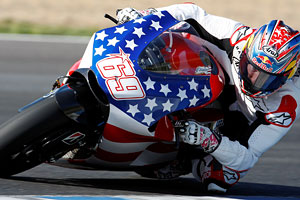Using your eyes is one of the most important aspects of motorcycle riding on the road or track.

Practice makes perfect
If you’ve been riding for a long time and are set in your ways of where you look while on the bike, then it may not feel 100 percent comfortable for you to suddenly look further ahead.
The ideal place to practice looking further ahead is on a tighter section of road (preferably a stretch of road that you know well) so your speed isn’t too high and there’s room for error. Even if you just repeat the same corner again and again, it’s essential to gain comfort in the changes of your vision.
Likewise on the track – practice looking ahead on the slower corners and then transfer the technique to faster corners as you gain comfort.
Once you’ve got it dialled, you’ll never turn back again.
Vision is an essential part of motorcycling. Using your eyes correctly can be the difference between hitting the correct apex on the racetrack or running wide lap after lap.
Where you are looking can also be the difference between slamming into a pothole or avoiding it on the public roads. Using your eyes correctly while riding greatly reduces the risk and possibility of an accident, too.
Firstly, we’ll look at the public roads and then move on to racetrack use later in the article.
It’s essential that you always look well ahead when riding on public roads and scan your upcoming route for hazards. Looking ahead enables you to pick up various potential dangers, whether it is traffic, an oil patch on the road or even a pedestrian crossing the road.
A common problem for many riders is that they tend to look down, just ahead of the front tyre, which makes the speed you are going at feel like it is faster than it really is.
Looking directly in front of your bike reduces your range of vision and therefore makes the speed you are going feel extra fast. Adjusting your vision and looking further ahead will open up a whole new world – reducing the feeling of the speed you are travelling at and making your ride a whole lot safer.
Another good point of keeping your vision up and well ahead of you is the increased ability to see traffic quickly coming to a halt or if an accident occurs in front of you.
Peripheral vision is also a very handy ‘tool’ when riding, as it further increases your ability to see a wide range of upcoming hazards, while also coming in handy if anything (an animal or child etc) is about to run on to the road from the side.
It’s also handy to keep check of the side streets where cars may drive into your lane without noticing you on the bike.
Keeping a broad range of vision at all times not only helps on the straights or in traffic, but it also assists you in selecting lines when out on your favourite stretch of open road.
For example, as you approach a sweeping section of bends, looking ahead to where you want to be enables you to thoroughly select your line of choice, allowing you to direct the bike in the safest possible way because you scanned the surface and surroundings well before you arrived at the corner.
If you were able to spot a car coming in the opposite direction, you then knew not to hug the inside of the lane too much. If you spotted a nasty section of loose gravel or road-kill, looking ahead gave you the opportunity to adjust your line and ride safely through the corner.
These skills also eliminate target fixation – a common cause of a crash as you get caught staring at a particular object. If you’re looking at a pothole just in front of you mid-corner then chances are you are likely to run straight over it.
Picking the pothole up earlier with your vision as you were scanning the road, and then looking further ahead to see what is coming up next, will allow you avoid the pothole and to prepare your lines for exactly what hazards are approaching.
Reference points are integral when riding if you want to be smooth and precise. If you can pick up where you want to brake, turn into the corner, apex the corner and then accelerate out of the corner, you will be rewarded with the benefits of scanning ahead.
A reference point can be things such as a paint line on the road, or a crack, or even a tree close to the side of the road – but it’s important to remember not to get target fixation on those points.
Riding on the track is a different story altogether. It is on the track where all of the points noted above are magnified, with vision and reference points proving critical if you want to improve.
Since you are travelling at very high speeds on the track, it’s even more important to look well ahead and use your eyes to pick up exactly where you want to be on the race track.
This is why you see the top racers in MotoGP and most racing series looking well ahead in the corners with their heads pointed toward the inside of the turn – they’re not just admiring the crowd!
Reference points are even more important on the circuit, assisting you in being more consistent and allowing you to really learn how to evolve your riding.
There are many reference points on tracks, including braking markers at some tracks and marshal points, as well as sponsor logos or whatever else there may be surrounding the circuit.
As long as it’s immovable then it’s a good reference point.
Don’t use your mate standing on the side of the track as a braking marker, because if he moves 50 metres down the track then all of a sudden you will be braking 50 metres later – resulting in big trouble.
Walking the track is a great way to find many reference points before you ride, enabling you to pick up markers that you may not see when on the bike with many distractions.
If you don’t have the opportunity to walk the circuit then an extra slow out-lap from the pits may do the trick.
Whether it be the track or road, vision is just as important as almost any other element of you riding. Work on it and enjoy the benefits.






